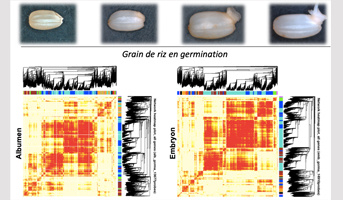The secrets of rice seed germination revealed by multi-omics integration
Seeds
Germination
Rice
Metabolism
Multi-omics
IJPB featured in a BAP INRAE division highlight, publication of the "Germination Physiology" team
As a major agronomic characteristic, the physiological quality of seeds is essential since it is the basis for plant production, biodiversity preservation and environmental respect. Germination performance and vigor of seeds and seedlings are key parameters for production and yield reliability 1 & 2. Germination may be restricted by physiological dormancy and/or unsuitable environmental conditions. Cereal seeds (e.g. rice, wheat, barley, maize) are monocotyledonous grains comprised of a large starchy endosperm and a small embryo. Rice (Oryza sativa) is the first crop whose genome has been publicly released 3. It is the most important cereal produced for human consumption in the world and is eaten on all continents, particularly in Asia, West Africa, and South America. Although the germination capability of rice seeds is governed by environmental and genetic factors, the molecular interactions between endosperm and embryo have never been addressed during this process.
Rice cultivation is of great importance for global food security. Seed germination is a crucial step to ensure agricultural performance. In cereals, this physiological process is initiated by water uptake of the dry starchy grain and ends with the elongation of the embryonic axis, which allows seedling establishment. The cellular and molecular mechanisms that control the success of germination are coordinated in the tissues of the embryo and the endosperm of the rice grain. Integrated high-throughput analyses of transcriptome, proteome, and metabolome dynamics, by the "Germination Physiology" PHYGERM team within a collaboration, during germination kinetics in the two major compartments of the rice grain illustrate the metabolic complementarity of the tissues. The endosperm not only provides nutrients to stimulate germination and growth, but also plays a protective role for the embryo through the synthesis of defense proteins.
Modern multi-omics approaches (e.g. transcriptomics, proteomics, and metabolomics) have been used to study the rice grain embryo and endosperm separately during germination, yielding a wealth of data highlighting the key biological functions and molecular/metabolic mechanisms related to the transition from dry to germinated seed.The dynamic changes detected in the endosperm during germination suggest that this compartment performs a critical function in protecting the embryo and promoting its growth potential.
These findings show not only key germination mechanisms, but also endosperm- and embryo-specific molecular responses that contribute to seed vigor. The extensive functional investigation of metabolic pathways and relevant genes, as well as the discovery of tissue-specific molecular markers, are promise for improving and characterizing rice seed quality and launching future breeding projects.
1 Rajjou et al., 2012. Annual review of plant biology, 63(507)
Doi: http://dx.doi.org/10.1146/annurev-arplant-042811-105550
2 Reed et al., 2022. Heredity, 1-10
Doi: https://doi.org/10.1038/s41437-022-00497-2
3 IRGS-Project, International Rice Genome Sequencing Project (2005). Nature 436(7052):793–800
Doi: https://doi.org/10.1038/nature03895
Rice cultivation is of great importance for global food security. Seed germination is a crucial step to ensure agricultural performance. In cereals, this physiological process is initiated by water uptake of the dry starchy grain and ends with the elongation of the embryonic axis, which allows seedling establishment. The cellular and molecular mechanisms that control the success of germination are coordinated in the tissues of the embryo and the endosperm of the rice grain. Integrated high-throughput analyses of transcriptome, proteome, and metabolome dynamics, by the "Germination Physiology" PHYGERM team within a collaboration, during germination kinetics in the two major compartments of the rice grain illustrate the metabolic complementarity of the tissues. The endosperm not only provides nutrients to stimulate germination and growth, but also plays a protective role for the embryo through the synthesis of defense proteins.
Modern multi-omics approaches (e.g. transcriptomics, proteomics, and metabolomics) have been used to study the rice grain embryo and endosperm separately during germination, yielding a wealth of data highlighting the key biological functions and molecular/metabolic mechanisms related to the transition from dry to germinated seed.The dynamic changes detected in the endosperm during germination suggest that this compartment performs a critical function in protecting the embryo and promoting its growth potential.
These findings show not only key germination mechanisms, but also endosperm- and embryo-specific molecular responses that contribute to seed vigor. The extensive functional investigation of metabolic pathways and relevant genes, as well as the discovery of tissue-specific molecular markers, are promise for improving and characterizing rice seed quality and launching future breeding projects.
1 Rajjou et al., 2012. Annual review of plant biology, 63(507)
Doi: http://dx.doi.org/10.1146/annurev-arplant-042811-105550
2 Reed et al., 2022. Heredity, 1-10
Doi: https://doi.org/10.1038/s41437-022-00497-2
3 IRGS-Project, International Rice Genome Sequencing Project (2005). Nature 436(7052):793–800
Doi: https://doi.org/10.1038/nature03895
Back

Legend: Graphical illustration of correlations between protein transcript and metabolite accumulation profiles in abumen (left) and embryo (right) during rice germination kinetics
IJPB & BAP INRAE division Highlights
"Germination Physiology" PHYGERM team
Associated publication
N Sano, I Lounifi, G Cueff, B Collet, G Clément, S Balzergue, S Huguet, B Valot M, Galland & L Rajjou (2022). Multi-Omics Approaches Unravel Specific Features of Embryo and Endosperm in Rice Seed Germination. Front. Plant Sci. 13. Doi: https://doi.org/10.3389/fpls.2022.867263
IJPB & BAP INRAE division Highlights
"Germination Physiology" PHYGERM team
Associated publication
N Sano, I Lounifi, G Cueff, B Collet, G Clément, S Balzergue, S Huguet, B Valot M, Galland & L Rajjou (2022). Multi-Omics Approaches Unravel Specific Features of Embryo and Endosperm in Rice Seed Germination. Front. Plant Sci. 13. Doi: https://doi.org/10.3389/fpls.2022.867263